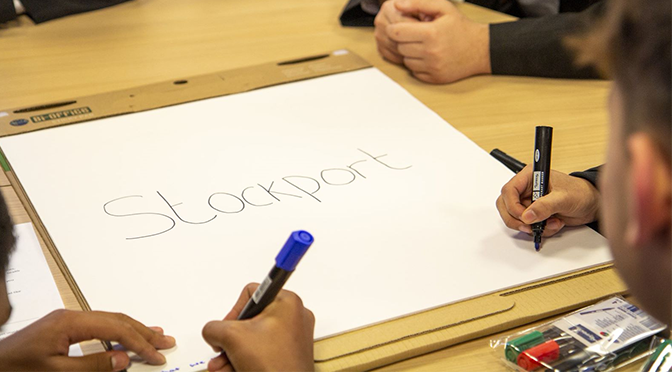Stockport Council’s ‘Strategy and Reform’ and ‘Design’ teams were previously two separate teams that worked in similar ways.
The Strategy and Reform team helps to deliver transformation and the strategic priorities of the authority. This involves providing programme and project management capacity and support, strategy development of key council strategies such as the borough plan, and performance monitoring the cabinet portfolios.
The Design team encompasses many different roles including: Business Analysts, User Experience designers, Content Designers and Service Designers. We all work together with a common purpose which is to design services that are best suited to the needs of all the users of that service. This can range from online content such as a new web page or online form, all the way to addressing culture change within the service itself.
Working together more closely
To get the best out of working together, the two teams have now been merged under one banner. Each team has brought something different to the table, be it a new way of thinking or an entirely new skillset, resulting in a combined breadth of skills and knowledge.
The Strategy and Reform team skillsets include project and programme management, stakeholder engagement, data analysis and policy research. Much of our work involves working with other teams in the council to support the delivery of strategic priorities, so it’s important that we can build positive relationships and quickly develop an understanding of the area of work. The use of agile methodology allows the team to identify and stand up capacity quickly and respond to emerging priorities. This also allows us to test new ideas and iterate our approach.
The diverse skillsets of the Design team include people with a creative flare as well as people that are grounded in what’s possible. This is what makes the team so formidable when tackling any problem or project. Because the two sides complement each other perfectly. If someone has an idea that at first doesn’t seem possible, it’s developed by the rest of the team until it’s concrete. Most of all, the entire Design team has a human centred design approach, meaning that we always design products and services for the users who need to access them.
Case study 1: Financial resilience programme
When working on the financial resilience programme, we were able to combine the Policy Research knowledge with Design’s knowledge of user-led design principles. This allowed us to develop personas of people in financial need that could then be used to influence service design.
As part of this project we wanted to understand the current offer within services and across the borough. Strategy and Reform colleagues were able to compile this offer, both through research, and liaising with relevant stakeholders. The Design team’s technical expertise about digital resources helped by visualising this map of offers using a Miro Design board. This improved understanding of the current context of the service offer and allowed for more engaging and fruitful sessions with stakeholders.

Image caption: Miro boards improve contextual understanding and engagement
Case study 2: Engagement projects
Design thinking and user focused methodologies have also proved useful outside of digital solutions.
As part of an engagement project with schools, we worked collaboratively to create a workshop for the students to take part in, developing activities that were both engaging for the students, but which produced valuable insights which could inform strategy development.
This was also the case during our collaborative work on the council’s Medium Term Financial Plan (MTFP) projects. The Strategy and Reform team were able to pair their stakeholder management and engagement skills with innovative user focussed methodologies brought by the Design team. Together we used customer journey mapping within stakeholder workshops to better understand the user’s experience and identify ‘pain points’ or inefficiencies that could be improved. This led to more user focussed discussions and solutions.

What’s next
The two teams are now integrated and we’re starting projects together, as opposed to being brought in at different stages of the design process. This means that the progression of the project becomes a group decision, and we can learn from one another from the outset, making the most out of everyone’s skillsets.
Looking ahead further, the new team’s combined knowledge and experience will be helpful in identifying potential services that could benefit from a design review.
And of course, we’re looking forward at some point to working together in the same physical space – something not currently possible due to Covid-19.
In the future, we would all like to see a continued effort to collaborate and to expand our team even further. Everyone has the ability to be a designer and to think using a human-centred design mindset, as we are slowly starting to prove.
We would also like to see our approach of joining teams together, to be shared with other services and even other organisations. Our team is starting to become more well-rounded and robust as a result.
If you are reading this and think that you could benefit from learning from someone else’s approach and mindset, then why not make the leap and approach them. Collaboration is the best way to grow in many different professions, so take every opportunity that comes your way.
For regular updates from the #DigitalStockport blog sign up for email alerts.

